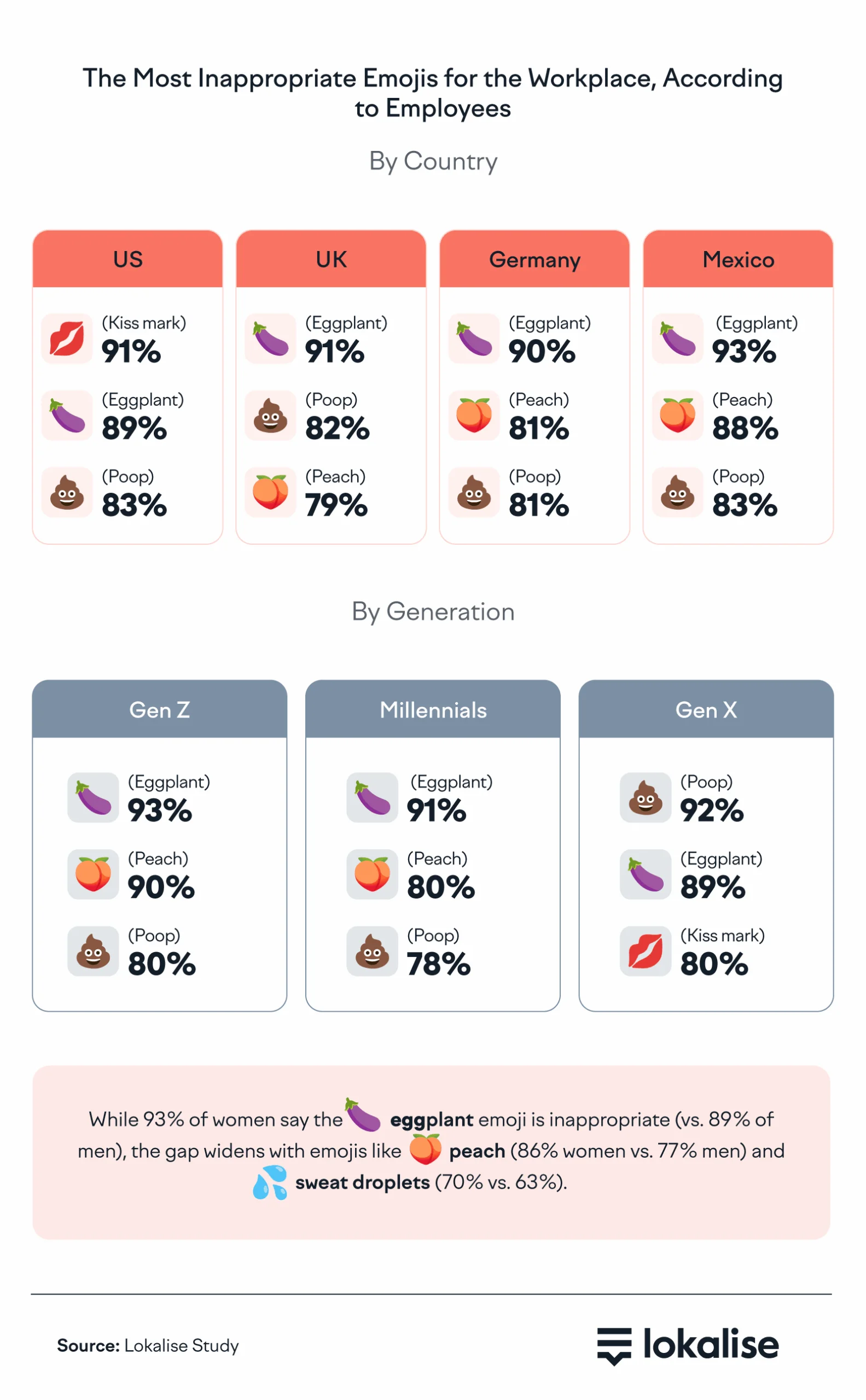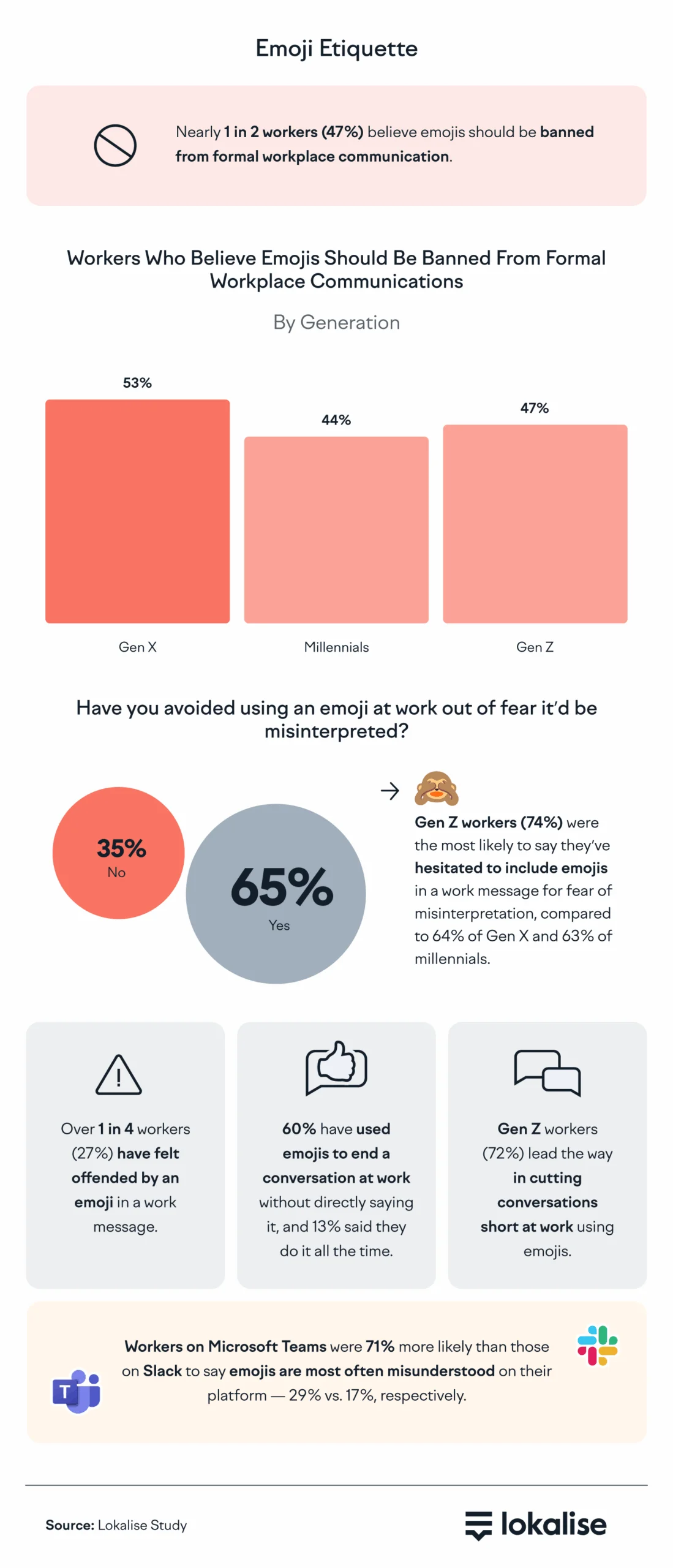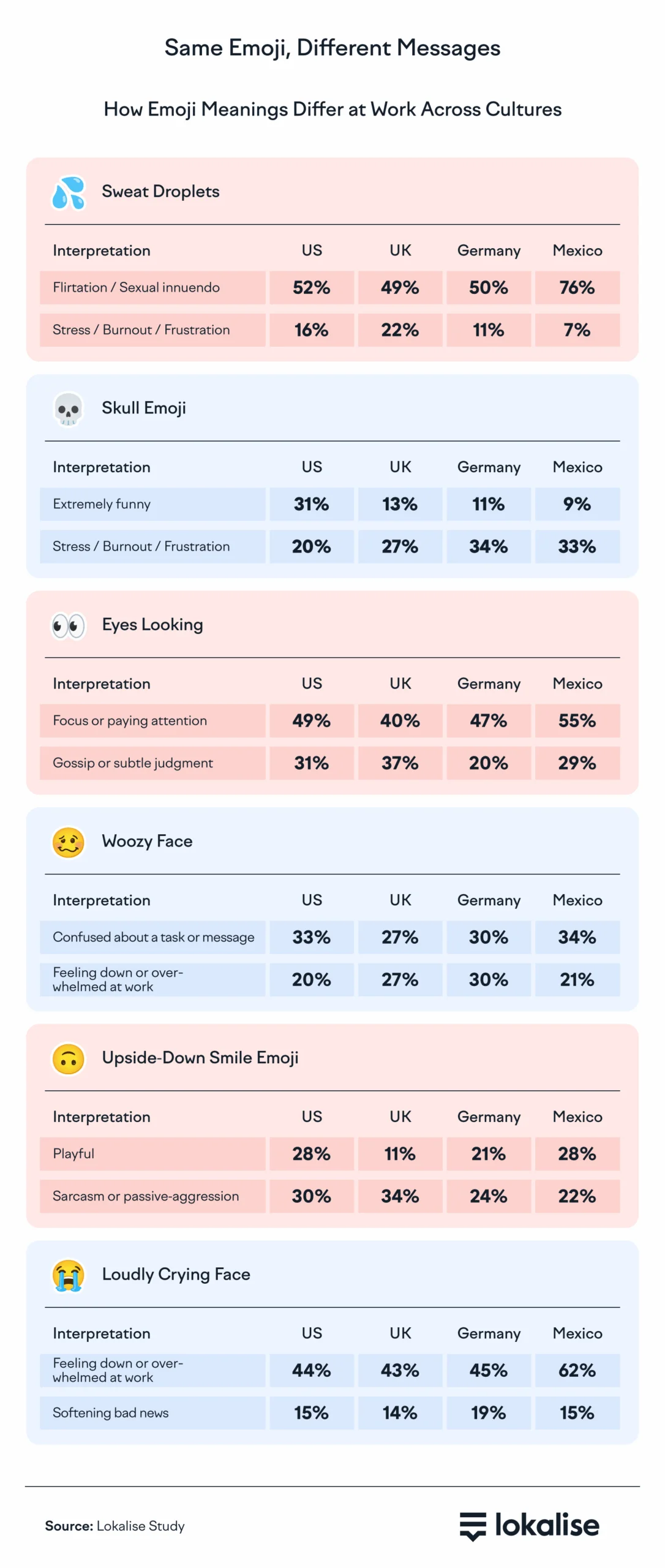Emojis feel like they should be a shared language in the digital world, but that’s not always the case. But when 👀 and 🤔 mean different things to different people, it’s easy for well-meaning messages to get misunderstood. To explore how emoji meanings shift across borders, platforms, and generations, we surveyed over 1,000 employees and consumers from the U.S., the U.K., Germany, and Mexico.
What we found was that cultural localization isn’t just for product pages and ad campaigns. It applies to every 👋 and 🙌 your brand sends, especially in work and customer communications.
Key takeaways
- 22% of consumers have muted or unfollowed a brand because its emoji use felt cringey or inauthentic.
- More than 1 in 3 consumers (38%) don’t believe brands know how to use emojis across different cultures.
- The eggplant emoji is seen as the most inappropriate for work, flagged by 91% of employees overall.
- Over 1 in 4 workers (27%) admit to having felt offended by an emoji in a work message.
- 1 in 3 workers (33%) have used an emoji to react to bad news at work, like a layoff, policy change, or warning.
- Nearly 1 in 2 workers (47%) believe emojis should be banned from formal workplace communication.
- 2 in 3 workers (65%) have avoided using an emoji at work out of fear it’d be misinterpreted.
- Workers on Microsoft Teams were 71% more likely than those on Slack to say emojis are most often misunderstood on their platform.
- WhatsApp ranks as the most confusing platform for using emojis, with 46% of workers saying emojis are most often misunderstood there.
Office emoji offenders
At work, emojis can add personality or get you into trouble. Our research found wide variation in what’s acceptable, what’s confusing, and what’s outright inappropriate on the job.

The clear winner of workplace emoji infamy was 🍆. A whopping 91% of employees agreed it’s not suitable for work communication. Other emojis carried much wider approval in professional settings, including the 👍 thumbs-up (82%), 👏 clapping hands (64%), and 🤝 handshake (62%).
Still, lines blur when emotions run high. One in three workers said they’ve used an emoji to respond to bad news at work, such as a layoff or disciplinary warning, especially among Gen Z and millennials (35% each).
For younger workers, emojis may serve as a way to soften the impact of bad news or to signal empathy without the weight of formal words. They’re also part of the digital shorthand that Gen Z and millennials are most comfortable using, helping them manage tone in tense situations.

Where misunderstandings happen most often also varies by platform. Workers identified WhatsApp as the most confusing (46%), followed by Instagram (38%) and Microsoft Teams (24%). By country, WhatsApp ranked highest for confusion in Mexico (82%), the U.K. (57%), and Germany (66%), while U.S. workers were most likely to point to Instagram (36%).
Avoided, offended, and misunderstood
If you’ve ever second-guessed sending an emoji to a coworker, you’re not alone. Sixty-five percent of employees said they’ve avoided using an emoji at work because they were afraid it would be misinterpreted.

Fears of emoji misunderstandings aren’t unfounded. Over a quarter of employees (27%) reported feeling offended by an emoji sent in a workplace message. Surprisingly, the rates were nearly identical across generations: 26% of Gen Z, 27% of millennials, and 28% of Gen X experienced offense.
Even among those comfortable with emoji use, misfires happen. Three in ten workers admitted they’ve misinterpreted an emoji from a peer, compared to just 9% who said the same about messages from customers, managers, or direct reports.
And if you’re using Microsoft Teams? Your odds of emoji confusion might be even higher. Workers on Teams were 71% more likely than Slack users to say emojis are regularly misunderstood on the platform.
Almost half of workers (47%) think emojis have no place in formal workplace communication. This opinion is shared most strongly in the U.S. (50%), compared to Mexico (47%), the U.K. (45%), and Germany (39%).
When brands misuse emojis
Brands eager to look relatable with emojis risk doing the opposite. Nearly one in four consumers (22%) have unfollowed or muted a brand because its emoji use felt cringey or fake.

Cultural context plays a major role here. A full 81% of consumers said emojis carry cultural meaning beyond what’s on the screen. This belief is highest in Mexico (89%) and the U.K. (85%), followed by the U.S. (79%) and Germany (78%). While 24% of Mexican consumers said they’ve changed how they use emojis after experiencing another culture, just 9% of U.S. consumers have done the same.
When brands ignore that context, consumers notice. More than a third (38%) don’t think companies know how to use emojis appropriately across cultures. The U.K. and the U.S. lead in emoji cringe, with 70% and 68% of consumers, respectively, saying brand emoji use often feels try-hard.
Cross-cultural emoji interpretations
One person’s innocent fruit emoji might be another’s not-safe-for-work symbol. Here’s a look at how people view the same emojis differently depending on their location.

The eggplant emoji was most widely interpreted as sexual in Mexico (92%), followed by the U.S. (83%), the U.K. (81%), and Germany (76%). The peach emoji followed a similar trend, with sexual connotations acknowledged by 87% of respondents in Mexico, 76% in the U.S., 73% in the U.K., and 68% in Germany.
Our findings highlight the importance of localizing even the smallest parts of your message. When meaning gets lost in translation, your brand credibility might, too.
Expert commentary: Why emojis go wrong for brands and workers
The data highlights a recurring theme: Emojis may feel universal, but their meanings are anything but. As Lokalise localization expert Etgar Bonar explained, “When consumers mute or unfollow a brand over cringey emoji use, it shows just how fragile digital trust can be. Emojis can be signals of tone and intent. If a brand misuses them, it risks looking out of touch or even disrespectful.”
Beyond consumer reactions, the workplace context shows similar pitfalls. “For younger generations, emojis are shorthand to soften a difficult message or show empathy,” continued Bonar. “But for others, the same emoji can come across as dismissive or unprofessional. That disconnect can create real tension.”
But the cross-cultural dimension is where brands most often stumble. “More than a third of consumers don’t believe brands know how to use emojis across cultures. Just like with language, localization is key. A symbol that’s playful in the U.S. can be inappropriate in Germany or confusing in Mexico,” said Bonar. “Brands that fail to account for this risk alienating audiences they’re trying to reach.”
Conclusion: Global emoji confusion is real
Whether you’re reacting to a message on Slack or creating a global marketing campaign, emoji misunderstandings are more common than you think. Across countries, generations, and platforms, what seems like a small icon can carry big meaning or big confusion. For companies and teams that communicate across borders, emoji literacy is essential. And just like text, tone, and visuals, emoji use should be localized with care.
Methodology
We surveyed 1,003 workers across four countries, the United States, the United Kingdom, Germany, and Mexico, to explore how they interpret and use emojis, particularly in digital communication with brands and in the workplace. The sample was distributed as follows: 50% from the U.S., 20% from the U.K., 15% from Germany, and 15% from Mexico.
The generational breakdown was:
- Gen Z: 21%
- Millennials: 56%
- Gen X: 20%
- Baby Boomers: 4%
Data was collected in August 2025.
About Lokalise
Lokalise is the leading platform for teams looking to scale and automate their localization efforts. From product copy and support articles to marketing assets and mobile apps, Lokalise helps businesses speak their customers’ language wherever they are. When it comes to communicating across cultures, context matters, and Lokalise makes sure nothing gets lost in translation.
Fair use statement
We encourage journalists and content creators to use our data and graphics, with a link back to Lokalise. For full access to the data set or to interview a Lokalise expert, please contact kip@frac.tl or nicole.franco@frac.tl.




